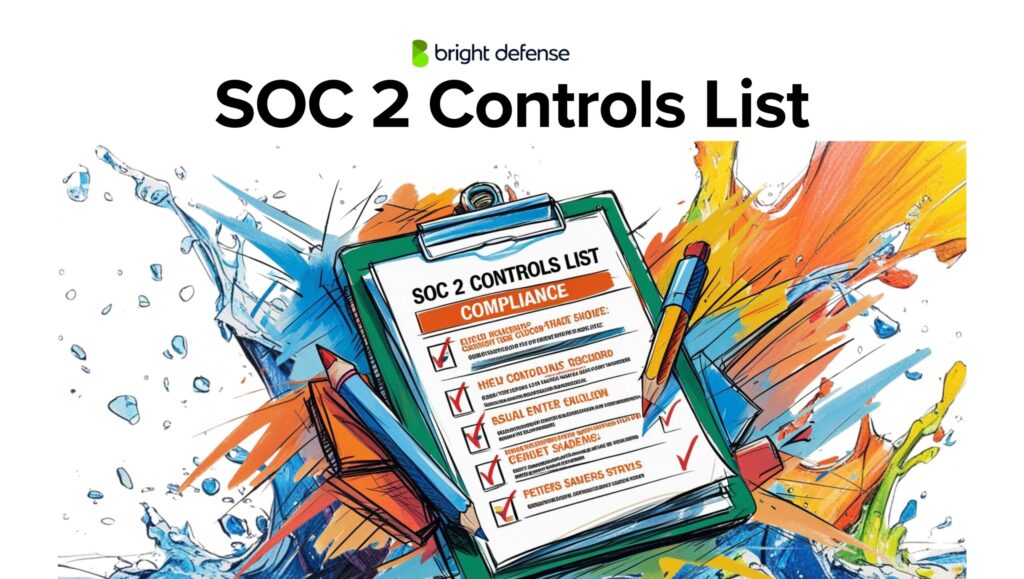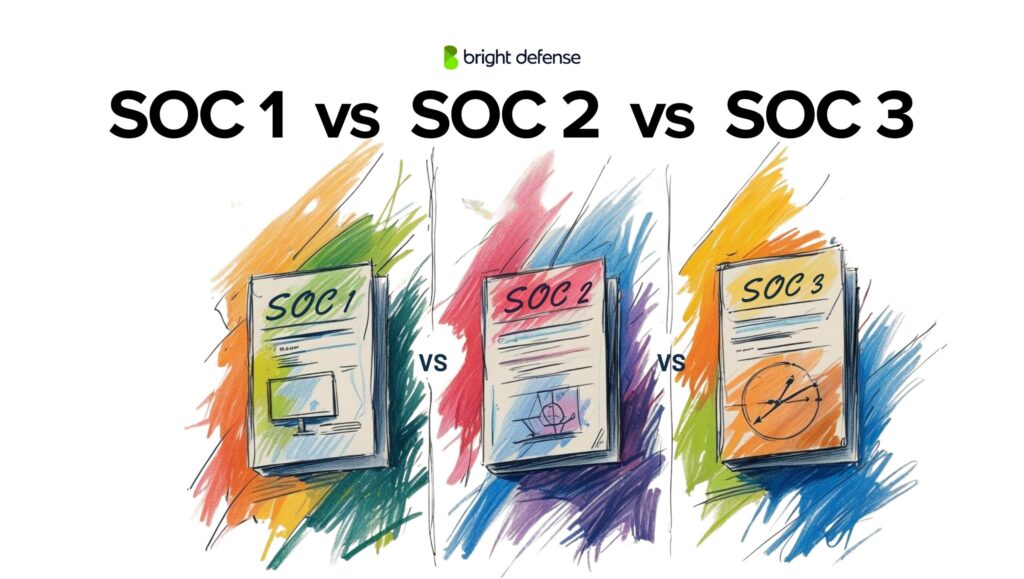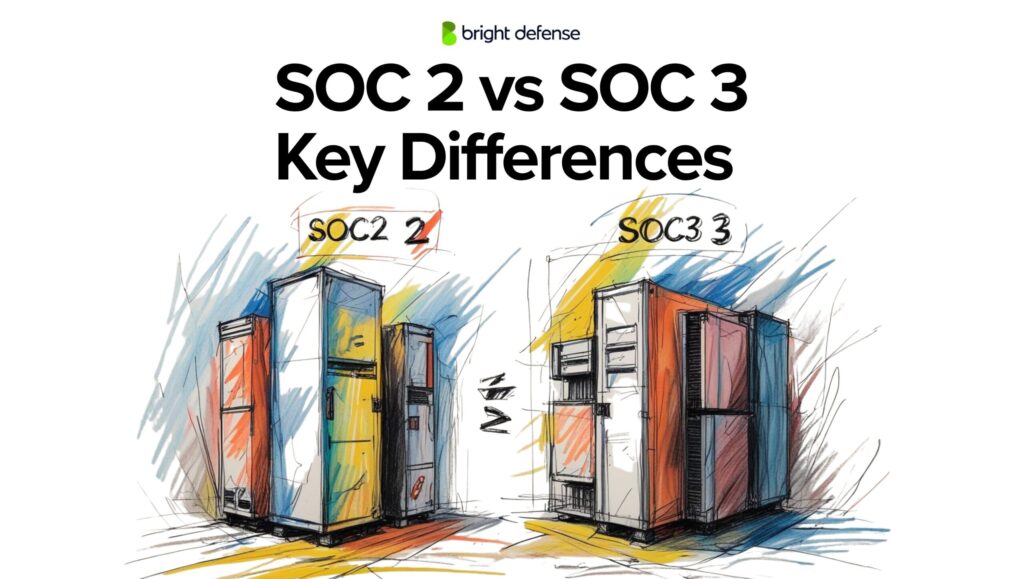
Tim Mektrakarn - CISSP | CISA | ISO 27001
June 28, 2025
Penetration Testing Pricing for 2025
One of the key practices in testing an organization’s security posture is to perform regular penetration testing. Organizations use these tests to simulate real-world attacks and uncover security gaps before malicious actors can exploit them.
In fact, the global penetration testing market reached $2.74 billion in 2025 and is projected to grow to $6.25 billion by 2032, according to Fortune Business Insights.
In this blog, we’ll take a close look at how much penetration testing may cost. We’ll cover the factors that influence pricing, the different types of tests, and what organizations should expect when budgeting for penetration testing services.
DIfferent Penetration Testing Costs At a Glance
- On average, businesses spend between $5,000 and $100,000 depending on the type and scope of penetration test ( Science Soft ).
- Internal Penetration Testing Cost: $7,000 – $35,000
- External Penetration Testing Cost: $5,000 – $20,000
- White Box Penetration Testing Cost: $500 – $2,000 per scan
- Black Box Penetration Testing Cost: $10,000 – $50,000 per scan
- Grey Box Penetration Testing Cost: $500 – $50,000
- Web Application Penetration Testing Cost: $5,000 – $30,000
While these reflect typical market rates, Bright Defense offers penetration testing plans at significantly lower cost without compromising on quality. See below for our pricing:
Bright Defense Penetration Testing Pricing
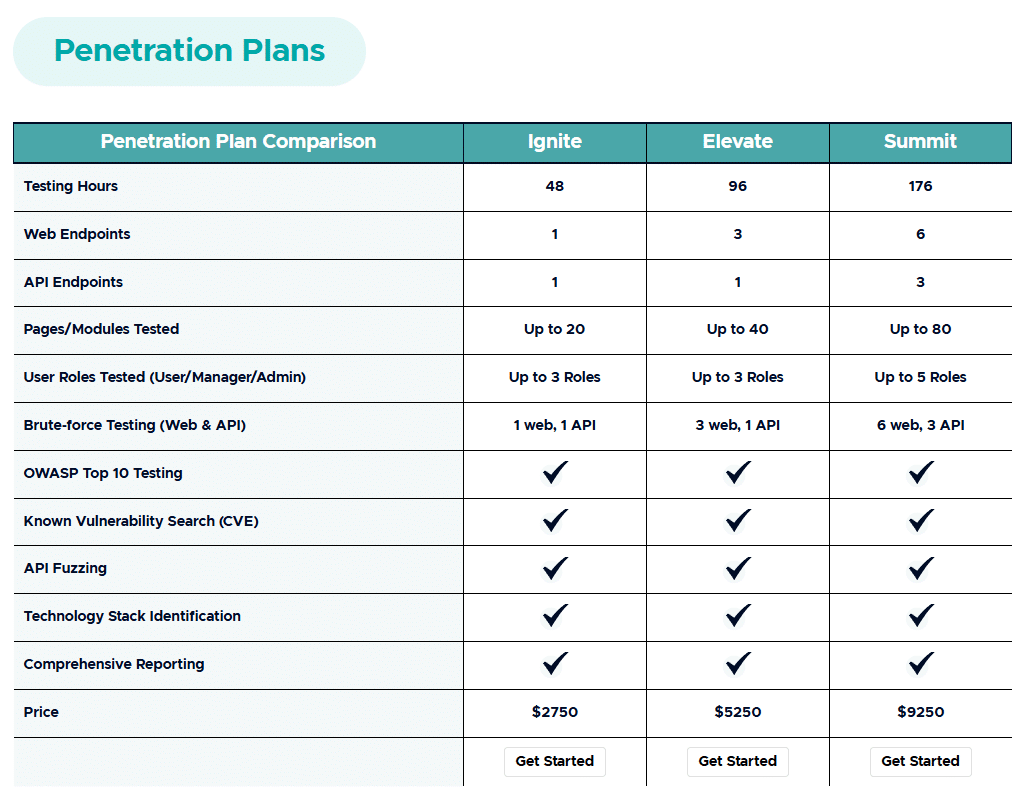
Checking Out the Various Types of Penetration Testing and their Costs
Penetration testing, often called pen testing, encompasses various types, each designed to evaluate different aspects of an organization’s security posture. The main types of penetration tests include:
Pen Testing Types and Pricing Table
| Penetration Test Type | Description | Typical Cost Range (USD) |
|---|---|---|
| Internal Penetration Test | Simulates insider threats or external attackers who have gained internal access. Tests weak passwords, unpatched systems, misconfigurations. | $7,000 – $35,000 |
| External Penetration Test | Simulates attacks from external actors. Targets public-facing assets like websites, services, and ports to identify entry points. | $5,000 – $20,000 |
| White Box Penetration Testing | Full access test with internal knowledge including source code and architecture. Deep, thorough audit for hidden vulnerabilities. | $500 – $2,000 per scan |
| Black Box Penetration Testing | No prior knowledge provided. Mimics real-world external hacker behavior. Focus on probing external weaknesses. | $10,000 – $50,000 per scan |
| Grey Box Penetration Testing | Partial system knowledge provided. Mimics a semi-informed attacker with limited access. Balances insight and realism. | $500 – $50,000 |
| Web Application Penetration Testing | Focuses on security of web apps. Identifies issues like XSS, SQL injection, and broken authentication. | $5,000 – $20,000 |
1. Internal Penetration Test
Internal penetration testing costs between $7,000 and $35,000.
Internal penetration testing simulates attacks that could occur if an attacker gains access to internal systems, whether through a malicious insider or by breaching perimeter defenses. Testers attempt to exploit internal weaknesses such as poor password policies, unpatched software, or misconfigured servers.
The price depends on network size, complexity, and the number of systems involved. Larger organizations with many internal assets usually fall on the higher end of the range.

2. External Penetration Test
External penetration test cost ranges are between $5,000 and $20,000.
External penetration testing evaluates the organization’s perimeter security by targeting internet-facing systems. Testers behave like outside attackers, scanning for open ports, exposed services, and vulnerable web applications.
Costs vary based on the number of external assets and the depth of testing required. A simple website test will cost less, while more complex environments with multiple domains, APIs, and services will increase pricing.

3. White Box Penetration Testing
White box penetration testing cost ranges between $500 and $2,000 per scan.
White box testing grants full access to the system, including source code, credentials, and architectural diagrams. With complete knowledge, testers can thoroughly audit the system and uncover deep-seated vulnerabilities that are often hard to spot during blind tests.
This method often applies to code reviews or application-level audits, which explains why it is priced per scan. The depth of analysis can drive costs higher, especially for large or complex applications.
4. Black Box Penetration Testing
Black box pen testing costs between $10,000 and $50,000 per scan.
Black box testing simulates a real-world attacker who has no prior knowledge of the system. Testers attempt to gather information, map the system, and find entry points without any internal data.
Since this method can require extensive reconnaissance and exploitation phases, costs tend to be higher, especially when testing broad or complex environments.

5. Grey Box Penetration Testing
Grey box penetration testing cost varies widely but can cost as little as $500 per scan and as much as $50,000.
Grey box testing gives testers partial knowledge of the system. They might receive limited credentials, documentation, or access, simulating an attacker with insider assistance or stolen credentials.
Pricing for grey box testing varies widely, depending on how much access is granted and how many systems are within scope. The hybrid nature of this method allows it to adapt to different testing needs.

6. Web Application Penetration Testing
The average penetration testing cost for web apps ranges between between $5,000 and $30,000.
Web application penetration testing focuses entirely on web-based systems. Testers evaluate business logic, input validation, authentication, and session management vulnerabilities.
Pricing depends on the complexity of the application, number of user roles, and depth of testing. A simple app with few pages may fall at the low end, while complex platforms with multiple integrations and sensitive data handling can push costs higher.

Factors Influencing the Cost of Penetration Testing
Several critical factors influence the cost of a penetration test. Understanding these elements helps organizations budget effectively for their cybersecurity needs. Let’s check them out:
1. Scope and Complexity
The scope of a penetration test directly impacts its cost. Testing a single web application is less expensive than assessing an entire corporate network. Larger scopes require more time and resources.
Complexity also plays a role. Environments with diverse technologies, legacy systems, or intricate network architectures demand specialized skills and tools, increasing costs.
Example: A basic e-commerce site might cost $5,000 to test, while a large enterprise with cloud, internal, and external assets could cost over $100,000. Complexity also matters. A simple tech stack is easier and faster to test. But an environment with legacy systems, multiple platforms, and custom apps demands more expertise and time, driving up the cost.
2. Expertise and Qualifications of the Penetration Tester
The skill level and certifications of penetration testers affect pricing. Highly experienced professionals with specialized expertise command higher rates. However, their proficiency often leads to more thorough and effective testing.
Example: A junior tester with basic certifications may charge less but might miss deeper vulnerabilities. In contrast, a tester with OSCP, CISSP, or CREST certifications and years of experience in application or network security will charge more, often $250 to $500 per hour, but deliver far more reliable and in-depth results. You’re paying for precision and fewer security blind spots.
3. Duration
The length of the penetration test influences the price. Comprehensive assessments that span several weeks are more costly than shorter engagements. Longer durations provide a more in-depth analysis of the security posture.
Example: A short test lasting a few days may cost around $10,000, while a multi-week engagement covering complex systems can exceed $50,000.
4. Tools and Technology
The sophistication and type of tools used can affect pricing. Advanced tools offer deeper insights but come at a higher cost. Custom tool development or unique testing solutions tailored to an organization’s infrastructure can significantly increase expenses.
Example: Advanced tools like Burp Suite Pro, Cobalt Strike, or custom-built scripts provide deeper coverage but raise costs. If the tester needs to develop custom tools to test proprietary systems, expect the price to climb even higher.
5. Manual vs. Automated Penetration Testing
Penetration tests can be automated, manual, or a combination of both. Automated testing is less costly but may miss complex vulnerabilities. Manual testing, requiring skilled testers to think creatively, is more expensive but often more effective at identifying and exploiting intricate security flaws.
Example: Automated tools are faster and cheaper but often miss logic flaws and complex attack paths. Manual testing is slower and more expensive but allows testers to mimic real-world attacks A hybrid approach is common for balancing cost and depth.
6. Legal and Compliance Considerations
Adhering to legal and regulatory standards adds to the cost. Compliance with laws like GDPR and HIPAA requires additional expertise and time. Thorough documentation and reporting to meet compliance standards increase the workload and overall cost. Liability insurance and other legal safeguards maintained by the testing firm also factor into pricing. Specific industry regulations may necessitate specialized testing protocols or certifications, further elevating costs.
Example: Basic penetration test for a non-regulated company might cost $15,000. But the same test for a healthcare provider needing HIPAA compliance could cost $30,000 or more. That’s because the report must meet legal audit standards, include detailed documentation, and follow strict testing procedures.
7. Remediation and Retesting Support
Many penetration testing engagements include support for remediation and retesting. This ensures identified vulnerabilities are addressed and fixes are effective. However, this additional phase adds to the total cost. Remediation support involves detailed guidance to help organizations address issues identified during testing. Retesting confirms that vulnerabilities have been resolved without introducing new issues.
Example: A company might pay $20,000 for the initial test, then an additional $5,000 to $10,000 for detailed remediation support and a full retest. While optional, skipping this phase increases the risk of unresolved security gaps.
8. Vendor Reputation and Location
The reputation and location of the vendor performing the penetration test significantly impact costs. Well-established vendors with a strong track record charge a premium.
These vendors typically have experienced professionals, advanced tools, and established methodologies.
The geographical location of the vendor also plays a role. Vendors in regions with high labor costs charge more than those in areas with lower costs of living.
Example: Well-known firms with a proven track record, charge a premium, often double what smaller or lesser-known firms might charge. You’re paying for name recognition, seasoned experts, and battle-tested methodologies. Location matters too. A U.S.-based vendor may charge $30,000 for the same project a vendor in Eastern Europe could deliver for $10,000, simply due to differences in labor and operational costs.
Pricing Models
Penetration testing services come with different pricing structures:
- Per-Hour vs. Per-Project: Some providers charge an hourly rate, typically ranging from $200 to $300 per hour.
- Retainer-Based Models: A retainer model may be more economical for ongoing testing.
- Value-Based Pricing: Some providers base their pricing on the value they bring to your organization.
- Bounty-Based: Larger organizations offer bounty programs that pay security experts based on the reported bug severity.
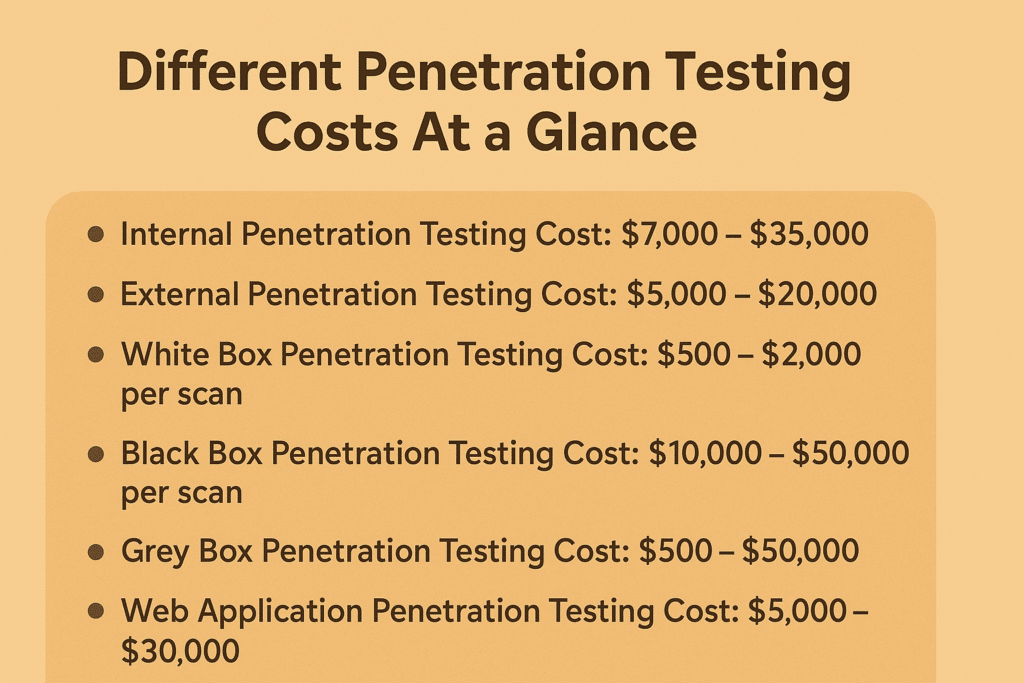
Understanding Different Penetration Testing Pricing Models
Penetration testing services come with different pricing structures:
- Per-Hour vs. Per-Project: Some providers charge an hourly rate. Typical hourly rates for qualified security experts in the United States range from $200 to $300 per hour.
- Retainer-Based Models: A retainer model may be more economical for ongoing testing.
- Value-Based Pricing: Some providers base their pricing on the value they bring to your organization.
- Bounty-Based: Larger organizations offer bounty programs that pay security experts based on the reported bug severity.
Each model has its pros and cons, and the right choice depends on your organization’s specific needs and budget.
Other Types of Pen Tests
Other types of pen tests include:
1. Social Engineering Test
Focuses on the human element of security, testing the organization’s personnel for susceptibility to social engineering tactics like phishing, pretexting, baiting, and tailgating.
2. Physical Penetration Test
Involves testing physical security controls like locks, sensors, cameras, and access control systems to assess the effectiveness of physical barriers in preventing unauthorized access. This manual penetration testing methodology involves someone trying to physically gain access to your facility.
3. Wireless Penetration Test
Focuses on wireless devices like wireless networks, Bluetooth, NFC, and other wireless communication systems to identify vulnerabilities like weak encryption and insecure protocols.
4. Cloud Penetration Testing
Cloud pentesting concentrates on cloud infrastructure assets, assessing vulnerabilities in configuration and service models like SaaS, PaaS, and IaaS.

Differences Between Penetration Testing and Vulnerability Scans
Understanding the differences between a penetration test and a vulnerability scan is crucial, especially when considering penetration testing costs and the overall cybersecurity strategy of an organization.
| Category | Penetration Testing | Vulnerability Scanning |
|---|---|---|
| Scope and Depth | In-depth, simulates real-world attacks to exploit weaknesses. | Surface-level, automated scan to find known vulnerabilities. |
| Methodology | Manual, performed by skilled testers mimicking real attackers. | Automated, software-driven scanning. |
| Cost Implications | Higher cost due to complexity, manual effort, and expertise. | Lower cost, efficient way to find common weaknesses. |
| Frequency and Use | Performed occasionally, often during major security reviews or system changes. | Conducted frequently as part of ongoing security maintenance. |
| Outcome and Reporting | Delivers detailed reports, exploited paths, and actionable remediation advice. | Provides a list |
1. Scope and Depth
Most penetration tests are comprehensive and simulate real-world attacks to exploit system weaknesses. They involve a series of controlled hacking attempts to test the resilience of the security infrastructure against data breaches.
In contrast, a vulnerability scan is more automated and surface-level, primarily designed to identify known vulnerabilities in systems and software.
2. Methodology
Penetration tests are often manual and require a skilled tester to think creatively, mimicking the actions of a potential attacker. This includes exploiting vulnerabilities, bypassing security features, and gaining unauthorized access.
Vulnerability scans, however, are mostly automated, relying on software to scan systems and networks for known vulnerabilities.
3. Cost Implications
Penetration testing costs are generally higher than vulnerability scans due to the in-depth nature, expertise required, and time investment.
Pen tests provide a more thorough assessment of security weaknesses, while vulnerability scans are a cost-effective way to identify and remediate known vulnerabilities.
4. Frequency and Use
Vulnerability scans are typically performed more frequently, often as part of regular security maintenance.
Penetration tests, on the other hand, are conducted less frequently, usually as part of a comprehensive security audit or when significant changes occur in the IT environment.
5. Outcome and Reporting
Penetration tests result in detailed reports outlining exploited vulnerabilities, the potential impact of a data breach, and recommendations for remediation.
Vulnerability scans generate a list of known vulnerabilities, often ranked by severity, but without the detailed exploitation and impact analysis found in most penetration tests.
In summary, while both penetration tests and vulnerability scans are important for cybersecurity, they serve different purposes. Penetration tests offer a deep, manual examination of potential security weaknesses, justifying their higher cost, whereas vulnerability scans provide a quicker, automated overview of known system vulnerabilities.

Estimating Your Penetration Testing Budget
Budgeting for pen testing varies. Small businesses might spend a few thousand dollars, while larger corporations could see costs in the tens of thousands. It’s essential to assess your needs carefully and prepare for potential additional costs that might arise during the testing process.
Here are some key cost drivers:
- Type of testing being performed, internal, external, or web application as described above
- Number of assets being tested, such as IPv4/IPv6 subnets
- Testing methodology: white box (testers receive full access, time-consuming), grey box, black box (testers receive no info or access, quicker due to limited knowledge)
Focusing in Web Application Pen Testing Pricing
Key cost drivers in Web Application penetrating testing include:
- Number of web applications
- Number of user roles being tested
- Number of unique pages such as app.domain.com/* → all pages under the root app domain
- API testing
Tips for Choosing a Penetration Testing Service
When selecting a pen testing service, consider:
- Provider’s Expertise and Reputation: Look for providers with proven experience and positive client testimonials. Some key accreditations include:
- Certified Ethical Hacker (CEH)
- Offensive Security Certified Professional (OSCP)
- CREST Certifications (including CRT, CCT, and CSA)
- GIAC Penetration Tester (GPEN)
- Licensed Penetration Tester (LPT)
- Certified Information Systems Security Professional (CISSP)
- TigerScheme Certifications
- CompTIA PenTest+
- Deliverables and Reports: Ensure the provider offers detailed reports that help you understand and address vulnerabilities.
- ROI of Services: Evaluate the cost versus the potential benefits to your organization’s security posture.

The Role of Penetration Testing in Compliance
Penetration testing is crucial in ensuring compliance with various cybersecurity frameworks and standards. It is an essential component in demonstrating an organization’s adherence to best practices in cybersecurity and in identifying potential vulnerabilities that malicious actors could exploit.
- SOC 2 and ISO 27001: Helps validate security controls and information security management systems, essential for protecting customer and company data.
- CMMC and NIST: It is crucial for contractors, especially in defense, to demonstrate adherence to cybersecurity practices and processes.
- HIPAA: Identifies security gaps in protecting patient health information, a core requirement for healthcare providers.
Continuous compliance is a modern necessity. Regular penetration testing is integral, offering ongoing assessments to meet evolving threats and regulatory demands, thereby supporting an organization’s commitment to robust cybersecurity.
Final Thoughts
Understanding the pricing of penetration testing is crucial in making informed decisions for your cybersecurity needs. It’s a balance of cost and quality, ensuring your business is protected without overspending. Remember, the cheapest option may not always be the most effective, and the most expensive one may not be necessary for your specific needs.

Penetration Testing from Bright Defense!
If you are interested in penetration test for your organization, Bright Defense can help. Bright Defense offers penetration testing and vulnerability scanning services through our partnership with Red Sentry and Breachlock. Both firms offer comprehensive services and exceptional support, and 5 star ratings on G2.
Bright Defense mission is to protect our clients from cybersecurity threats through continuous compliance. Additionally, we offer services including continuous cybersecurity compliance, managed security awareness training, AI-enable phishing, and virual CISO (vCISO) services. We understand that penetration testing is a key component to meeting compliance standards.
If you are interested in a penetration test quote, contact our security team today.
FAQ: Understanding Penetration Testing Pricing
1. What is Penetration Testing?
Penetration testing, or pen testing, is a simulated cyberattack against your computer system, network, or web application to identify vulnerabilities and security issues.
2. What Factors Affect Penetration Testing Pricing?
The cost of penetration testing can vary based on several factors, including the scope and complexity of the project, the expertise required, duration, tools and technology used, and legal and compliance considerations.
3. What Are the Different Types of Penetration Tests?
There are mainly three types:
- Internal Pen Testing: Focuses on evaluating the security of internal networks and systems.
- External Pen Testing: Concentrates on identifying and exploiting vulnerabilities in external-facing assets.
- Web Application Pen Testing: Exclusively assesses the security of web applications.
4. What Are the Different Pricing Models for Penetration Testing?
Penetration testing services may offer various pricing models, such as per-hour or per-project rates, retainer-based models, value-based pricing, and bounty-based programs.
5. How Much Should I Budget for Penetration Testing?
The cost can range from a few thousand dollars for small businesses to tens of thousands for larger corporations. It depends on the type of testing, number of assets, and testing methodology.
7. Can Penetration Testing Prevent Cybersecurity Breaches?
Yes, by identifying and addressing vulnerabilities proactively, penetration testing can prevent security breaches that might lead to significant financial and reputational damages.
8. Is There a Difference Between Manual and Automated Penetration Testing?
Yes. Automated scans can identify common vulnerabilities, but manual testing by expert pen testers is critical for a more thorough and insightful assessment.
9. How Long Does Penetration Testing Take?
The duration varies based on the scope and complexity of the project. It can range from a few days to several weeks.
10. Are There Any Specific Legal or Compliance Issues to Consider in Penetration Testing?
Yes, ensuring that penetration testing complies with relevant laws and regulations is crucial, as it can add layers of complexity and cost to the process.
11. How Often Should Penetration Testing Be Conducted?
Regular testing is recommended, especially when significant changes are made to your systems or applications, or at least annually.
12. Can Penetration Testing Disrupt My Business Operations?
Professional penetration testers typically conduct tests in a manner that minimizes disruption to normal business operations.
13. How Do I Know if the Penetration Test Was Successful?
Success is measured by the thorough identification of vulnerabilities and the provision of actionable recommendations for strengthening your cybersecurity defenses.
14. Can Small Businesses Afford Penetration Testing?
Yes, there are cost-effective options available for small businesses, and considering the potential costs of a breach, it’s a worthwhile investment.
15. Where Can I Learn More About Bright Defense’s Penetration Testing Services?
For more information about our services, visit our partnership pages with Red Sentry and Breachlock, which offer comprehensive services and exceptional support.
Get In Touch

